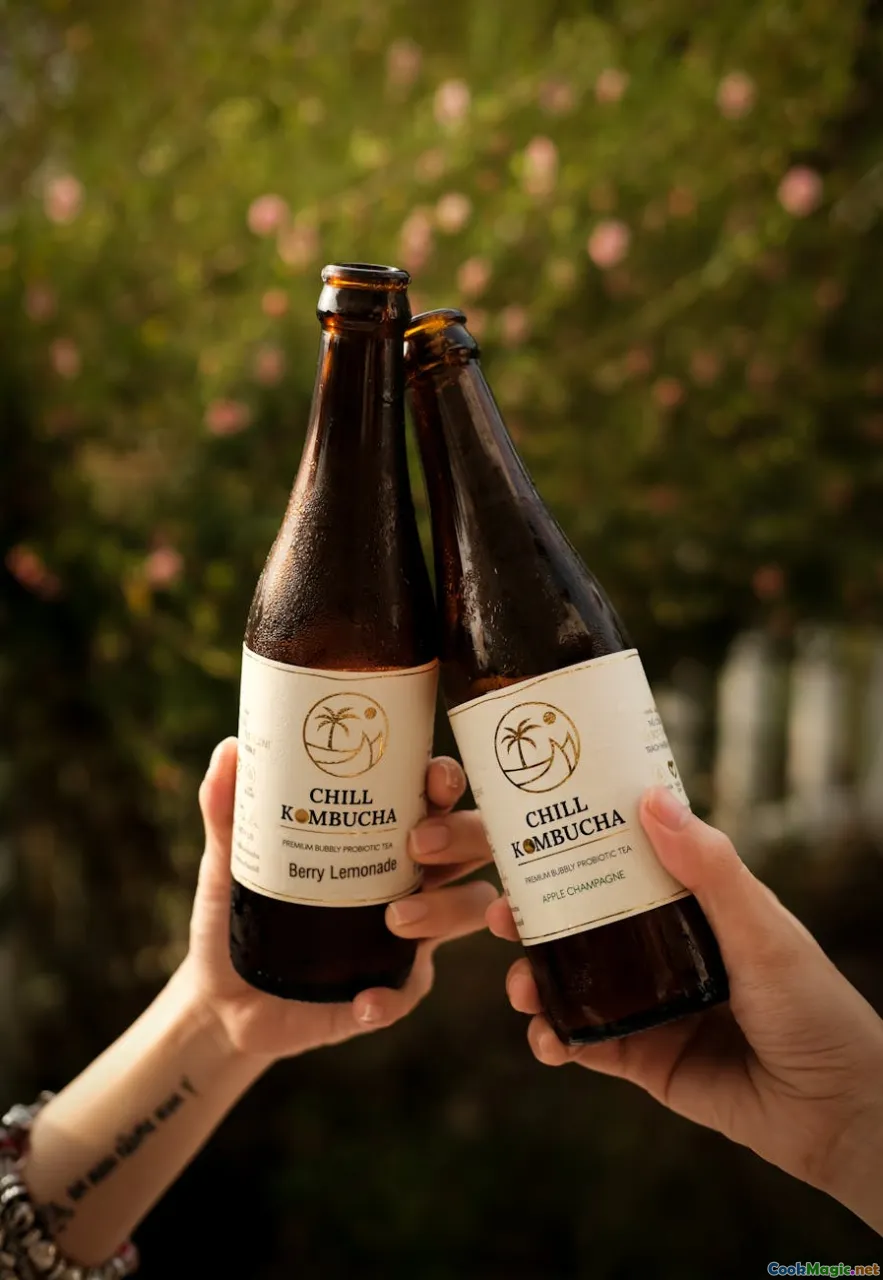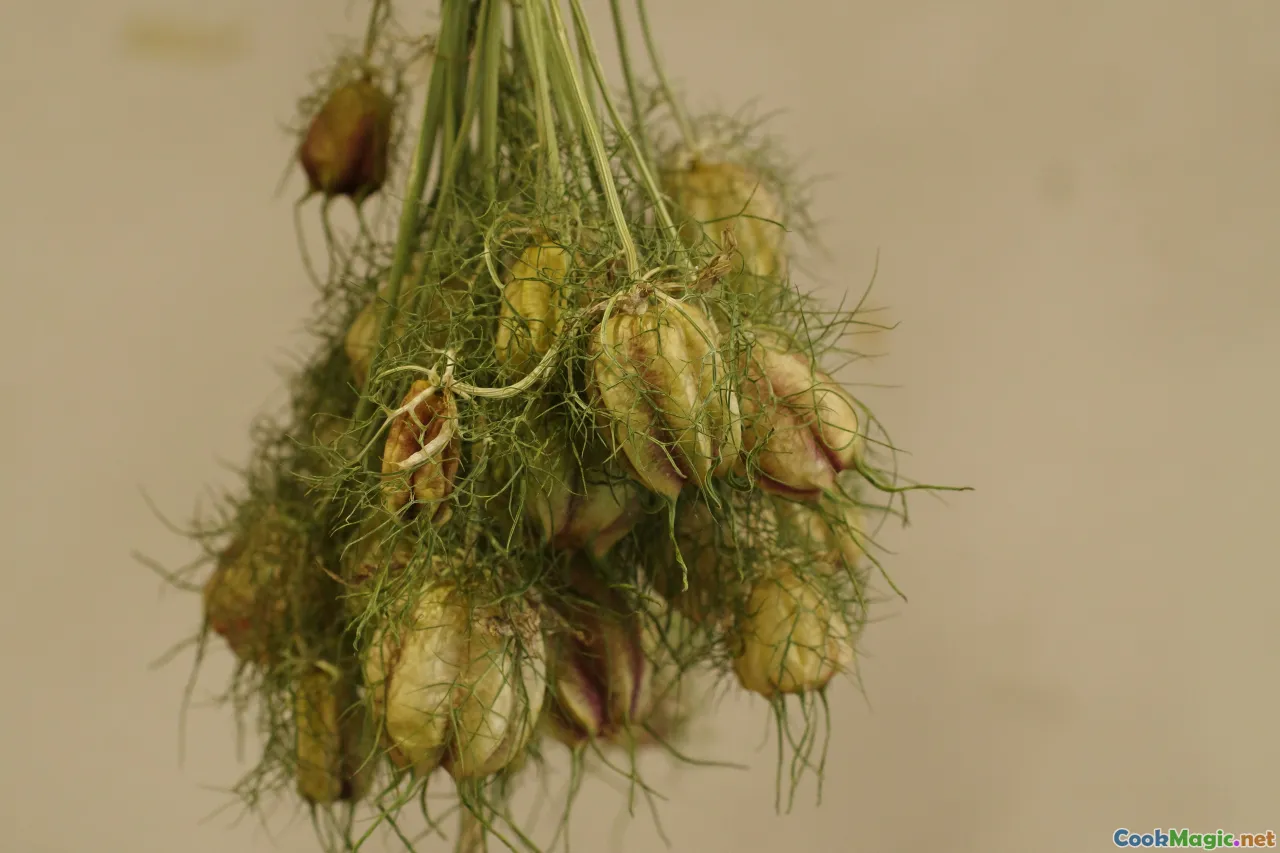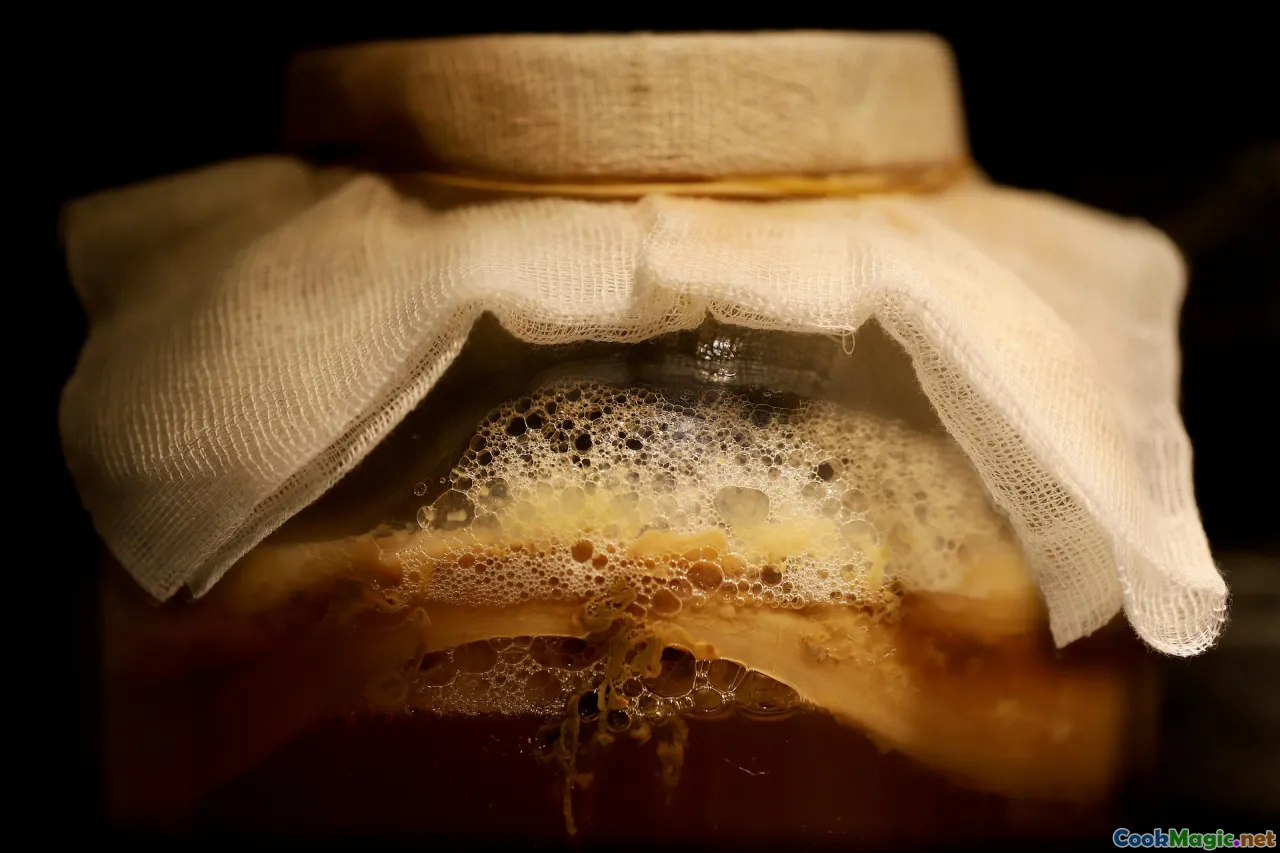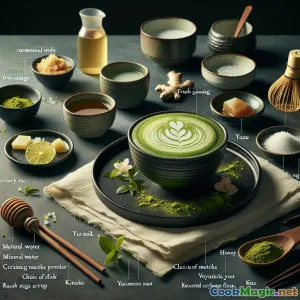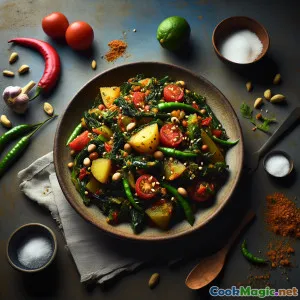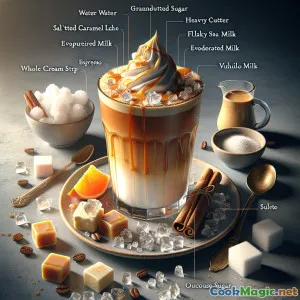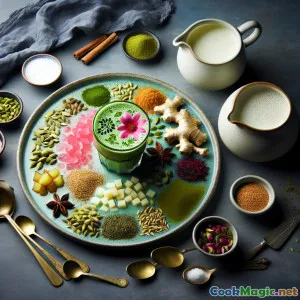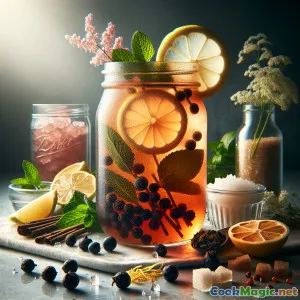
Ngụm Kombucha Quế và Cây Tùng Bắc Âu
(Nordic Juniper & Elder Kombucha Sip)
(0 Đánh giá)0
1,009
tháng 8 24, 2025
Báo cáo sự cố
Nguyên liệu
-
1.5 liters Nước lọc
(Room temperature or cold)
-
3 tablespoons Trà đen rải
(English Breakfast or Assam)
-
100 grams Đường mía thô
(White sugar works as alternative)
-
2 tablespoons quả mộc qua
(Nghiền nhẹ)
-
1.5 tablespoons Hoa kim elder khô
(Subs: fresh or elderflower cordial (reduce sugar))
-
1 disk Kombucha SCOBY
(Symbiotic Culture of Bacteria and Yeast)
-
200 ml Starter kombucha
(From previous batch or store-bought, unflavored)
-
1 teaspoon Vỏ chanh
(Bào sợi tươi)
-
8 leaves Lá bạc hà tươi
(Trang trí (tùy chọn))
(Room temperature or cold)
(English Breakfast or Assam)
(White sugar works as alternative)
(Nghiền nhẹ)
(Subs: fresh or elderflower cordial (reduce sugar))
(Symbiotic Culture of Bacteria and Yeast)
(From previous batch or store-bought, unflavored)
(Bào sợi tươi)
(Trang trí (tùy chọn))
Dinh dưỡng
- Khẩu phần: 4
- Kích thước khẩu phần: Một ly lớn (350ml)
- Calories: 60 kcal
- Carbohydrates: 14 g
- Protein: 0 g
- Fat: 0 g
- Fiber: 0 g
- Sugar: 12 g
- Sodium: 7 mg
- Cholesterol: 0 mg
- Calcium: 15 mg
- Iron: 0.2 mg
Hướng dẫn
-
1 - Steep Tea and Botanicals:
Bring water just off the boil. Add loose black tea, juniper berries, and elderflowers. Steep for 15 minutes, then strain into a clean glass jar.
-
2 - Sweeten and Cool:
Stir in raw cane sugar until dissolved. Allow the tea mixture to cool to room temperature before proceeding.
-
3 - Assemble Fermentation Vessel:
Add cooled, sweetened infusion to a sterilized jar. Add starter kombucha, lemon zest, and place SCOBY gently on top.
-
4 - Ferment:
Cover jar with a breathable cloth and a rubber band. Let ferment at room temperature (18–24°C) for 3–5 days, tasting from day 3 for tartness.
-
5 - Bottle and Carbonate:
Remove the SCOBY. Pour kombucha through a fine sieve into clean bottles. Seal tightly and leave at room temp 1–2 days to carbonate.
-
6 - Chill and Serve:
Refrigerate bottles for at least 4 hours. Serve chilled with fresh mint leaves, if desired.
Bring water just off the boil. Add loose black tea, juniper berries, and elderflowers. Steep for 15 minutes, then strain into a clean glass jar.
Stir in raw cane sugar until dissolved. Allow the tea mixture to cool to room temperature before proceeding.
Add cooled, sweetened infusion to a sterilized jar. Add starter kombucha, lemon zest, and place SCOBY gently on top.
Cover jar with a breathable cloth and a rubber band. Let ferment at room temperature (18–24°C) for 3–5 days, tasting from day 3 for tartness.
Remove the SCOBY. Pour kombucha through a fine sieve into clean bottles. Seal tightly and leave at room temp 1–2 days to carbonate.
Refrigerate bottles for at least 4 hours. Serve chilled with fresh mint leaves, if desired.
Thông tin thêm về: Ngụm Kombucha Quế và Cây Tùng Bắc Âu
Nordic Juniper & Elder Kombucha: A Modern Botanical Ferment
Introduction & Cultural Context
Inspired by the unspoiled forests, foraged ingredients, and ancient brewing traditions of both England and Scandinavia, the Nordic Juniper & Elder Kombucha bridges cultures and centuries. Blending creamy, round black tea notes with pine-fresh juniper and fragrant elderflower yields a unique celebration of both English rural orchards and piney Nordic woods. Kombucha has exploded in popularity across the globe for its low sugar, probiotic potential, and vivid flavors—this version respects those roots while forging new territory with a focus on local botanicals often found wild in northern latitudes.
History & Origins
Kombucha, a fermented sweet tea, originally hails from East Asia but quickly traversed Europe via trade routes over the centuries. The English picked up a love of both black tea (especially breakfast-style blends) and floral compotes made with elder and foraged berries—traditional herbal-cure culture running through its history. Simultaneously, juniper berries are a staple Nordic flavor, most famous perhaps in gin but also used for teas, folk remedies, and festive foods. Here, drying elderflowers or using homegrown or wild ones brings an authentic, grassy sweetness, gently lifted by the evergreen tang of juniper.
Why This Recipe Stands Out
Where most kombucha recipes invoke usual tropical fruit or ginger heat, the Nordic Juniper & Elder points toward heady English gardens and conifer forests, channeling botanical finesse into your glass. Adding lemon zest further brightens flavor and underscores both regions’ reverence for simple, pristine freshness.
Advantages of DIY kombucha include:
- Customizable tang and fizz level: Bottle sooner for softer brews or later for sharper, drier, more sparkling kombucha
- Botanical adventure: Swap of ratio between berries, flowers, or try with green tea for Nordic spring reimagining
- Probiotic power: Unpasteurized, selves harbor friendly bacteria and acids believed to benefit gut health.
Tips for Perfection
- Always ferment in glass, never reactive metal or plastic. Cleanliness is paramount! Each batch supports a growing, healthy SCOBY.
- Starters must be unflavored (or minimally flavored), so as not to overwhelm subtle botanicals like elder or juniper.
- Avoid using too much juniper! It’s aromatic but can turn medicinal in strength, so measure gently.
- To make it pretty, strain through cheesecloth for extra clarity, swirling in a few edible flowers for summer-special hosts.
Serving Suggestions & Uses
Pour over ice for a woodland picnic, or serve in stemmed glasses with delicate herbal canapes. Kombucha is ideal as a non-alcoholic aperitif or a new-wave brunch spritzer. Even drizzle a splash into gin cocktails for an English-Nordic intersection.
Variations to Explore
- Replace the mint garnish with a ribbon of cucumber for even more freshness.
- Try substituting the black tea base for green tea to draw out different floral tones, more like Nordic meadows.
- Some like to add a teaspoon of wildflower honey after first fermentation, bottle for a sweet, meadowy fizz (be careful with carbonation levels!)
Final Thought
This kombucha is more than just a refreshing beverage—it’s an edible story, where England and Scandinavia meet in a journey from ancient foraging to cutting-edge cuisine. Infuse your kitchen with oral tradition and living ingredients, and let every batch be uniquely yours, dependent on season, foraging, and spirit!

